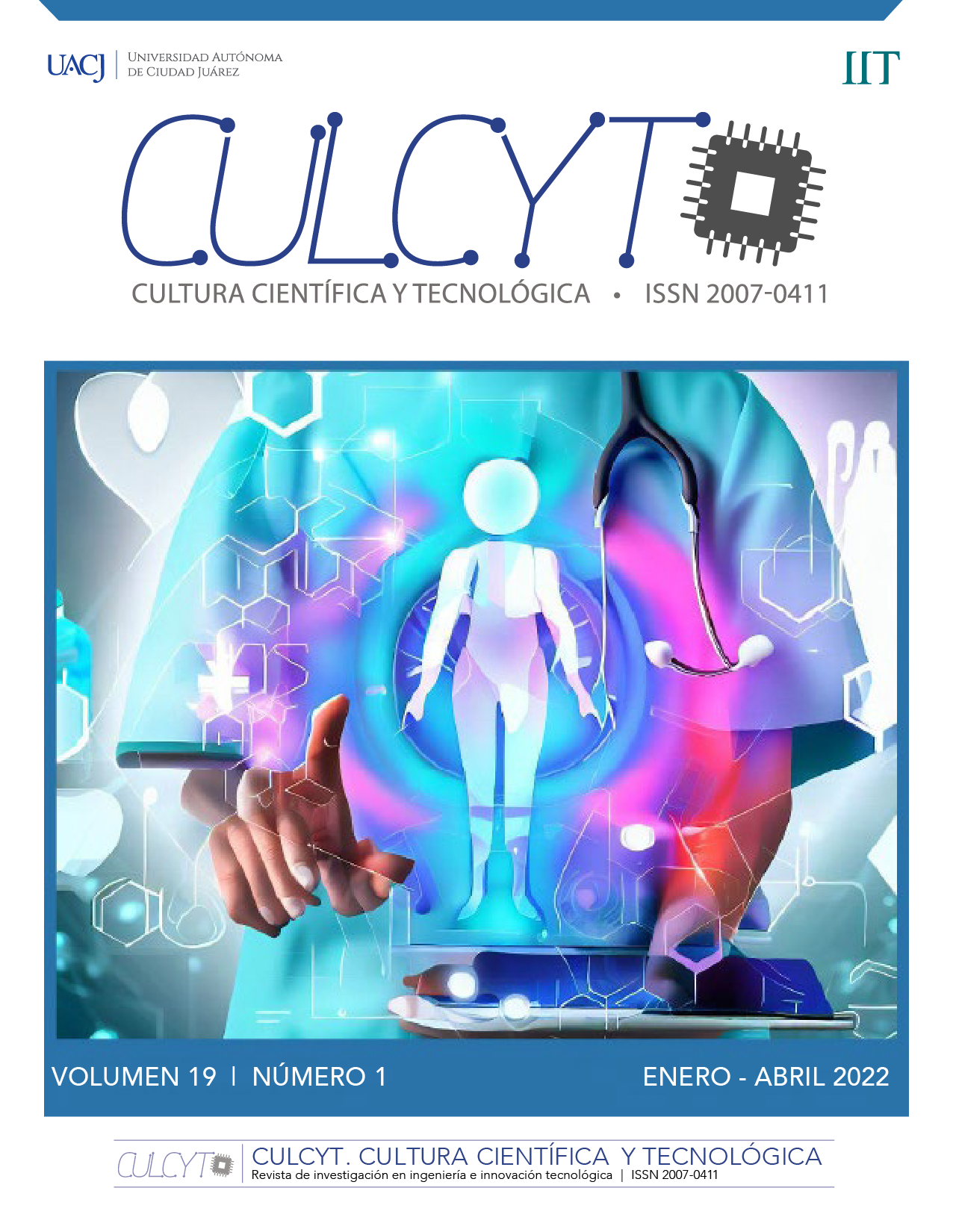Smart architecture for software-defined networking
DOI:
https://doi.org/10.20983/culcyt.2022.1.2.2Abstract
Software-defined networks (SDN) seek to solve the problems in current network schemes by simplifying their management through their reprogrammability and accessibility to the overall network infrastructure. One aspect to improve in SDN-based schemes is the precise classification of your traffic load, this can improve various aspects such as quality of service, dynamic access control, prioritized random access, among others. This research aims to propose a conceptual architecture of SDN and evaluate different machine learning methods for traffic classification. To this end, SDN architectures are analyzed and different modules are proposed to strengthen their management with the help of low computational cost classifiers. The architecture proposes the following main modules: Capture network traces module, Learning Engine module, and ML-model and Flow classifier. To determine the model to be used in the Learning Engine and Flow classifier modules, different classifiers were evaluated using a database of network traffic, as a result, it was determined that the gradient boosting algorithm is the most suitable to be integrated with the proposed SDN architecture.
Downloads
References
N. Noorani y S. A. H. Seno, “SDN- and fog computing-based switchable routing using path stability estimation for vehicular ad hoc networks”, Peer-to-Peer Netw. Appl., vol. 13, pp. 948-964, may. 2020, doi: 10.1007/s12083-019-00859-4.
A. R. Mohammed, S. A. Mohammed y S. Shirmohammadi, “Machine Learning and Deep Learning Based Traffic Classification and Prediction in Software Defined Networking”, 2019 IEEE International Symposium on Measurements & Networking (M&N), 2019, pp. 1-6, doi: 10.1109/IWMN.2019.8805044.
J. Mejia, L. Avelar-Sosa, B. Mederos, E. Santiago y J. D. Díaz, “Prediction of time series using an analysis filter bank of LSTM units”, Comput Ind Eng, vol. 157, 2021, doi: 10.1016/j.cie.2021.107371.
K. Sood, S. Yu y Y. Xiang, “Software-Defined Wireless Networking Opportunities and Challenges for Internet-of-Things: A Review”, en IEEE Internet of Things Journal, vol. 3, no. 4, pp. 453-463, ag. 2016, doi: 10.1109/JIOT.2015.2480421.
S. H. Rastegar, A. Abbasfar y V. Shah-Mansouri, “Rule Caching in SDN-Enabled Base Stations Supporting Massive IoT Devices With Bursty Traffic”, en IEEE Internet of Things Journal, vol. 7, no. 9, pp. 8917-8931, sept. 2020, doi: 10.1109/JIOT.2020.3000393.
B. K. Mukherjee, S. I. Pappu, M. J. Islam y U. K. Acharjee, “An SDN based distributed IoT network with NFV implementation for smart cities”, en Cyber Security and Computer Science, T. Bhuiyan, M. M. Rahman y M. A. Eli, Eds., Springer, Cham, 2020, doi: 10.1007/978-3-030-52856-0_43.
Y. -W. Ma, Y. -C. Chen y J. -L. Chen, “SDN-enabled network virtualization for industry 4.0 based on IoTs and cloud computing”, 2017 19th International Conference on Advanced Communication Technology (ICACT), 2017, pp. 199-202, doi: 10.23919/ICACT.2017.7890083.
L. Silva, P. Pedreiras, P. Fonseca y L. Almeida, “On the adequacy of SDN and TSN for Industry 4.0”, 2019 IEEE 22nd International Symposium on Real-Time Distributed Computing (ISORC), 2019, pp. 43-51, doi: 10.1109/ISORC.2019.00017.
A. Yazdinejad, R. M. Parizi, A. Dehghantanha, Q. Zhang y K. -K. R. Choo, “An Energy-Efficient SDN Controller Architecture for IoT Networks With Blockchain-Based Security”, en IEEE Transactions on Services Computing, vol. 13, no. 4, pp. 625-638, 1 jul.-ag. 2020, doi: 10.1109/TSC.2020.2966970.
M. M. Raikar, S. M. Meena, M. M. Mulla, N. S. Shetti y M. Karanandi, “Data Traffic Classification in Software Defined Networks (SDN) using supervised-learning”, Procedia Comput. Sci., vol. 171, pp. 2750-2759, 2020, doi: 10.1016/j.procs.2020.04.299.
M. Amiri, H. Al Osman y S. Shirmohammadi, “Game-Aware and SDN-Assisted Bandwidth Allocation for Data Center Networks”, 2018 IEEE Conference on Multimedia Information Processing and Retrieval (MIPR), 2018, pp. 86-91, doi: 10.1109/MIPR.2018.00023.
S. Gangadhar y J. P. G. Sterbenz, “Machine learning aided traffic tolerance to improve resilience for software defined networks”, 2017 9th International Workshop on Resilient Networks Design and Modeling (RNDM), 2017, pp. 1-7, doi: 10.1109/RNDM.2017.8093035.
P. Goransson, C. Black y T. Culver, Software defined networks: a comprehensive approach, Morgan Kaufmann, 2016.
N. McKeown et al., “Openflow: enabling innovation in campus networks”, ACM SIGCOMM Computer Communication Review, vol. 38, no. 2, pp. 69-74, 2008, doi: 10.1145/1355734.1355746.
R. Mosquera, O. D. Castrillón y L. Parra, “Máquinas de Soporte Vectorial, Clasificador Naïve Bayes y Algoritmos Genéticos para la Predicción de Riesgos Psicosociales en Docentes de Colegios Públicos Colombianos”, Inf. Tecnol., vol. 29, no. 6, pp. 153-162, 2018, doi: 10.4067/S0718-07642018000600153.
P. Horton y K. Nakai, “Better Prediction of Protein Cellular Localization Sites with the it k Nearest Neighbors Classifier”, en Proc Int Conf Intell Syst Mol Biol, vol. 5, pp. 147-152, jun. 1997.
S. R. Safavian y D. Landgrebe, “A survey of decision tree classifier methodology”, en IEEE Transactions on Systems, Man, and Cybernetics, vol. 21, no. 3, pp. 660-674, may.-jun. 1991, doi: 10.1109/21.97458.
V. F. Rodriguez-Galiano, B. Ghimire, J. Rogan, M. Chica-Olmo y J. P. Rigol-Sanchez, “An assessment of the effectiveness of a random forest classifier for land-cover classification”, ISPRS J. Photogramm. Remote Sens., vol. 67, pp. 93-104, 2012, doi: 10.1016/j.isprsjprs.2011.11.002.
G. Biau, B. Cadre y L. Rouvìère, “Accelerated gradient boosting”, Mach Learn, vol. 108, no. 6, pp. 971-992, 2019, doi: 10.1007/s10994-019-05787-1.
J. S. Rojas, A. Pekar, Á. Rendón y J. C. Corrales, “Smart User Consumption Profiling: Incremental Learning-Based OTT Service Degradation”, en IEEE Access, vol. 8, pp. 207426-207442, 2020, doi: 10.1109/ACCESS.2020.3037971.
Downloads
Published
How to Cite
Issue
Section
License
Copyright (c) 2022 Jose Mejia, Oliverio Cruz-Mejia, José Alfredo Acosta-Favela, Alejandra Mendoza-Carreón, René Noriega-Armendáriz

This work is licensed under a Creative Commons Attribution-NonCommercial 4.0 International License.
Todos los contenidos de CULCYT se distribuyen bajo una licencia de uso y distribución “Creative Commons Reconocimiento-No Comercial 4.0 Internacional” (CC-BY-NC). Puede consultar desde aquí la versión informativa de la licencia.
Los autores/as que soliciten publicar en esta revista, aceptan los términos siguientes: a) los/las autores/as conservarán sus derechos de autor y garantizarán a la revista el derecho de primera publicación de su obra; y b) se permite y recomienda a los/las autores/as agregar enlaces de sus artículos en CULCYT en la página web de su institución o en la personal, debido a que ello puede generar intercambios interesantes y aumentar las citas de su obra publicada.



